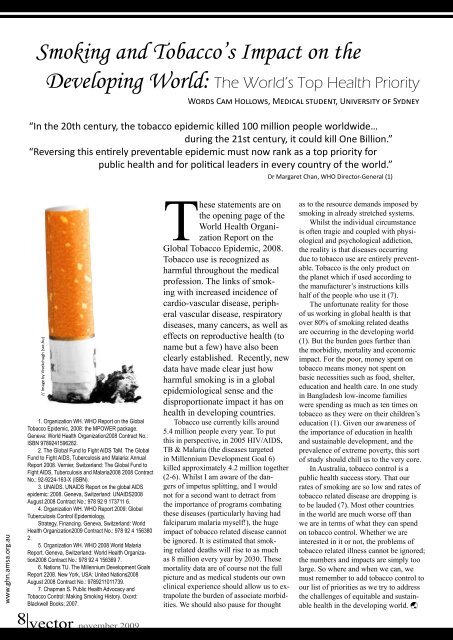Create successful ePaper yourself
Turn your PDF publications into a flip-book with our unique Google optimized e-Paper software.
Smoking and Tobacco’s Impact on the<br />
Developing World: The World’s Top Health Priority<br />
Words Cam Hollows, Medical student, University of Sydney<br />
“In the 20th century, the tobacco epidemic killed <strong>10</strong>0 million people worldwide…<br />
during the 21st century, it could kill One Billion.”<br />
“Reversing this entirely preventable epidemic must now rank as a top priority for<br />
public health and for political leaders in every country of the world.”<br />
Dr Margaret Chan, WHO Director-General (1)<br />
www.ghn.amsa.org.au<br />
// Image by Vivekchugh (sxc.hu)<br />
1. Organization WH. WHO Report on the Global<br />
Tobacco Epidemic, 2008: the MPOWER package.<br />
Geneva: World Health Organization2008 Contract No.:<br />
ISBN 9789241596282.<br />
2. The Global Fund to Fight AIDS TaM. The Global<br />
Fund to Fight AIDS, Tuberculosis and Malaria: Annual<br />
Report 2008. Vernier, Switzerland: The Global Fund to<br />
Fight AIDS, Tuberculosis and Malaria2008 2008 Contract<br />
No.: 92-9224-163-X (ISBN).<br />
3. UNAIDS. UNAIDS Report on the global AIDS<br />
epidemic: 2008. Geneva, Switzerland: UNAIDS2008<br />
August 2008 Contract No.: 978 92 9 173711 6.<br />
4. Organization WH. WHO Report <strong>2009</strong>: Global<br />
Tuberculosis Control Epidemiology,<br />
Strategy, Financing. Geneva, Switzerland: World<br />
Health Organization<strong>2009</strong> Contract No.: 978 92 4 156380<br />
2.<br />
5. Organization WH. WHO 2008 World Malaria<br />
Report. Geneva, Switzerland: World Health Organization2008<br />
Contract No.: 978 92 4 156369 7.<br />
6. Nations TU. The Millennium Development Goals<br />
Report 2208. New York, USA: United Nations2008<br />
August 2008 Contract No.: 978921<strong>10</strong>11739.<br />
7. Chapman S. Public Health Advocacy and<br />
Tobacco Control: Making Smoking History. Oxord:<br />
Blackwell Books; 2007.<br />
These statements are on<br />
the opening page of the<br />
World Health Organization<br />
Report on the<br />
Global Tobacco Epidemic, 2008.<br />
Tobacco use is recognized as<br />
harmful throughout the medical<br />
profession. The links of smoking<br />
with increased incidence of<br />
cardio-vascular disease, peripheral<br />
vascular disease, respiratory<br />
diseases, many cancers, as well as<br />
effects on reproductive health (to<br />
name but a few) have also been<br />
clearly established. Recently, new<br />
data have made clear just how<br />
harmful smoking is in a global<br />
epidemiological sense and the<br />
disproportionate impact it has on<br />
health in developing countries.<br />
Tobacco use currently kills around<br />
5.4 million people every year. To put<br />
this in perspective, in 2005 HIV/AIDS,<br />
TB & Malaria (the diseases targeted<br />
in Millennium Development Goal 6)<br />
killed approximately 4.2 million together<br />
(2-6). Whilst I am aware of the dangers<br />
of impetus splitting, and I would<br />
not for a second want to detract from<br />
the importance of programs combating<br />
these diseases (particularly having had<br />
falciparum malaria myself!), the huge<br />
impact of tobacco related disease cannot<br />
be ignored. It is estimated that smoking<br />
related deaths will rise to as much<br />
as 8 million every year by 2030. These<br />
mortality data are of course not the full<br />
picture and as medical students our own<br />
clinical experience should allow us to extrapolate<br />
the burden of associate morbidities.<br />
We should also pause for thought<br />
as to the resource demands imposed by<br />
smoking in already stretched systems.<br />
Whilst the individual circumstance<br />
is often tragic and coupled with physiological<br />
and psychological addiction,<br />
the reality is that diseases occurring<br />
due to tobacco use are entirely preventable.<br />
Tobacco is the only product on<br />
the planet which if used according to<br />
the manufacturer’s instructions kills<br />
half of the people who use it (7).<br />
The unfortunate reality for those<br />
of us working in global health is that<br />
over 80% of smoking related deaths<br />
are occurring in the developing world<br />
(1). But the burden goes further than<br />
the morbidity, mortality and economic<br />
impact. For the poor, money spent on<br />
tobacco means money not spent on<br />
basic necessities such as food, shelter,<br />
education and health care. In one study<br />
in Bangladesh low-income families<br />
were spending as much as ten times on<br />
tobacco as they were on their children’s<br />
education (1). Given our awareness of<br />
the importance of education in health<br />
and sustainable development, and the<br />
prevalence of extreme poverty, this sort<br />
of study should chill us to the very core.<br />
In Australia, tobacco control is a<br />
public health success story. That our<br />
rates of smoking are so low and rates of<br />
tobacco related disease are dropping is<br />
to be lauded (7). Most other countries<br />
in the world are much worse off than<br />
we are in terms of what they can spend<br />
on tobacco control. Whether we are<br />
interested in it or not, the problems of<br />
tobacco related illness cannot be ignored;<br />
the numbers and impacts are simply too<br />
large. So where and when we can, we<br />
must remember to add tobacco control to<br />
our list of priorities as we try to address<br />
the challenges of equitable and sustainable<br />
health in the developing world. <br />
8 vector november <strong>2009</strong>
















